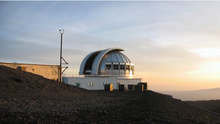United Kingdom Infrared Telescope
 |
|
| Location(s) |
Mauna Kea |
|---|---|
| Coordinates | 19°49′21″N 155°28′14″W / 19.8225°N 155.47069444444°WCoordinates: 19°49′21″N 155°28′14″W / 19.8225°N 155.47069444444°W |
| Telescope style |
infrared telescope |
|
|
|
|
[]
|
|
UKIRT, the United Kingdom Infra-Red Telescope, is a 3.8 metre (150 inch) infrared reflecting telescope, the second largest dedicated infrared (1 to 30 micrometres) telescope in the world. Until 2014 it was operated by the Joint Astronomy Centre in Hilo and located on Mauna Kea, Hawai'i as part of Mauna Kea Observatory. It was owned by the United Kingdom Science and Technology Facilities Council. UKIRT is currently being funded by NASA and operated under a Scientific Cooperation Agreement among Lockheed Martin Advanced Technology Center, the University of Hawaii, and the University of Arizona. The telescope is set to be decommissioned in the near future as part of the Mauna Kea Comprehensive Management Plan.
Like related telescopes on Tenerife, it is a Cassegrain device with a thin primary mirror, around 2/3 thinner than in other contemporary devices and weighing only 6.5 tonnes. The mirror is held in a massive steel 'cell' of 20 tonnes which is linked to the supports by Serrurier trusses. The instrument is held and pointed by a massive 'English Equatorial mounting' or yoke which sits on ball-bearings on steel piers, swinging east-west and rotating around north-south. The geometry of the mount limits the telescopes access to objects between +60 and -40 degrees of declination but it is extremely sturdy and free from deformation and so allows very accurate pointing. The telescope was built between 1975 and 1978; the mechanical systems were built by Dunford Hadfields of Sheffield and the optics by Grubb Parsons of Newcastle. Originally known as the Infrared Flux Collector it began operation in October 1979.
With the delivery of the wide-field imager WFCAM in 2004, UKIRT began a revolutionary large-scale sky survey (the UKIRT Infrared Deep Sky Survey, UKIDSS). This project takes some 80% of the available telescope time in wide-field mode. Wide-field takes some 60% of the telescope; the other 40% is devoted to operations with the Cassegrain instrumentation. In December 2008 it was announced that the telescope would be moving to wide-field mode full-time [1].
...
Wikipedia
